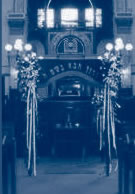|
SEDRAS : VAYAKHEL-PEKUDEI- HACHODESH :
Hertz Chumash p. 373 Exodus Ch. 35
This week's Sedra is generously sponsored by Boris Gelberg.
SYNOPSIS SEDRA : VAYAKHEL
("And he (Moses) assembled the people...) Moses transmitted
the details of G-d's commands relating to the construction
of the Sanctuary and its contents. However, he first emphasised
- in the presence of the entire nation congregated before
him - that the Holiness of the Shabbat overrides all other
considerations, even work on G-d's own house.
The response of the people when first asked to contribute
to the building of the Sanctuary was exceedingly generous,
each individual donating whatever he could. Skilled women
spun the materials. The tribal Princes each offered precious
stones for the breastplate of the High Priest as well as oil
and spices for the incense. Some women even donated their
mirrors of highly burnished copper for the manufacture of
the Laver and its vase.
Moses emphasised that Betzalel of the tribe of Judah had been
singled out for his talent, wisdom and understanding of the
details of the construction. His colleague Oholiav of the
tribe of Dan was similarly talented, especially as an engraver
and weaver. The gifts for building the Sanctuary became so
plentiful it was necessary to ask the donors to stop bringing
more materials.
The Sanctuary and its contents soon began to take shape,
section by section.
SEDRA PEKUDE :
At Moses' instruction the total cost of the Sanctuary was
computed. The work was inspected and approved by Moses who
invoked G-d's blessing on the people for their participation
and assistance in bringing this Holy project to a magnificent
conclusion. On the 1st of the month Nisan - almost a year
since the Exodus, the Sanctuary was erected under Moses' personal
supervision and the contents were arranged in the prescribed
order. A cloud blanketed the Sanctuary which was filled with
G-d's Glory. Whenever the cloud lifted it signalled G-d's
desire for the Israelites to continue their journey.
IN SOME YEARS THESE SEDRAS COINCIDE WITH THE SHABBAT HACHODESH.
IN THOSE YEARS A SPECIAL MAFTIR AND HAPHTORAH IS RECITED.
SPECIAL MAPHTIR - HACHODESH HERTZ CHUMASH P. 253 Exodus
Chap. 12
The Maphtir introduces the month of Nisan, month of redemption
and is a major source of the laws of Passover.
THE HAPHTORAH - HACHODESH HERTZ CHUMASH P. 1001 Ezekiel
Chap. 45 16
Ezekiel describes the Temple rebuilt in the "New Jerusalem"
and makes particular reference to the Passover sacrifices.
This continues the theme of the special Maphtir for Shabbat
Hachodesh.
TELL ME RABBI ..... THE MONTH OF NISSAN
"This month shall be for you the beginning of months;
it shall be the first month of the year for you" (Shemot
12:2)
The world was created in Nissan (Rosh Hashanna 11)
"This month shall be for you the beginning of months":
The Jewish people consider Nissan as the first month, and
all other months, the second, the third, etc., should be counted
according to it. Each time we count the months, we also remember
the miracle of the Exodus. This is why the months have no
name in the Torah for example "the third month",
"in the second year, in the second month, the cloud was
lifted" (Bamidbar 10:11); "and on the first day
of the seventh month" (Bamidbar 29:1), and so on with
all the months.
In a similar way we remember the Sabbath day, by counting
the days of the week in accordance to it. However, when reckoning
years, we do not count from Nissan but from Tishre. (Ramban,
Parshat Bo). The names "Tishre", "Nissan"
etc. originated during the time of the Persian/Babylonian
exile.
Nissan is the month of redemption. In this month our forefathers
were redeemed from Egypt, and in this same month the Jewish
people will eventually be redeemed again, hopefully soon in
our days. In this month our forefathers Abraham, Yitzchak
and Yaacov were born (according to Rabbi Yoshua's opinion),
and the Mishkan (Tabernacle) was set up (Shemot 40:2). Also,
the princes of each tribe brought their offerings for the
dedication of the mishkan. (Rosh Hashanna 11).
CUSTOMS FOR THE MONTH OF NISSAN
During the time of the Bet Hamikdash, our sages established
the rule to teach the people thirty days before any one of
the three festivals regarding its laws, so from Purim onwards,
we begin studying the laws of Pesach.
It is customary to omit those additional prayers which are
mournful or supplicatory since Nissan is the month of redemption.
This is also based on the fact that on the completion of the
Mishkan on the first of Nissan the princes of the tribes began
offering their korbanot (sacrifices) for the dedication of
the altar, one prince each day, until the 13th of Nissan.
Each prince made a celebration on the day of his offering.
On the eve of Pesach the whole of Israel rejoiced, as they
all brought the Pesach offering. After this follow the eight
days of Pesach. Except for the 13th of Nissan, which has no
special event, and the last few days of Nissan, most of the
month was spent in holiness. Thus the whole month is considered
a `Yom Tov' a period of Joy.
KIMCHA D'PISCHA - "flour for Pesach"
It was customary to buy wheat to distribute among the poor
before Pesach in order to enable them to have Matzot for the
Festival. This custom is particularly apt for our Festival
of Freedom when we recline and relax as a sign of prosperity.
It is an affront to G-d, if at such a time we ignore the plight
of those who are in need. Today various funds exist in Jewish
communities to enable families in need to buy supplies required
for Pesach and the Seder.
Congregants wishing to contribute locally should get in touch
with Rabbi.
BACK TO SHABBAT SHALOM
TABLE
|








